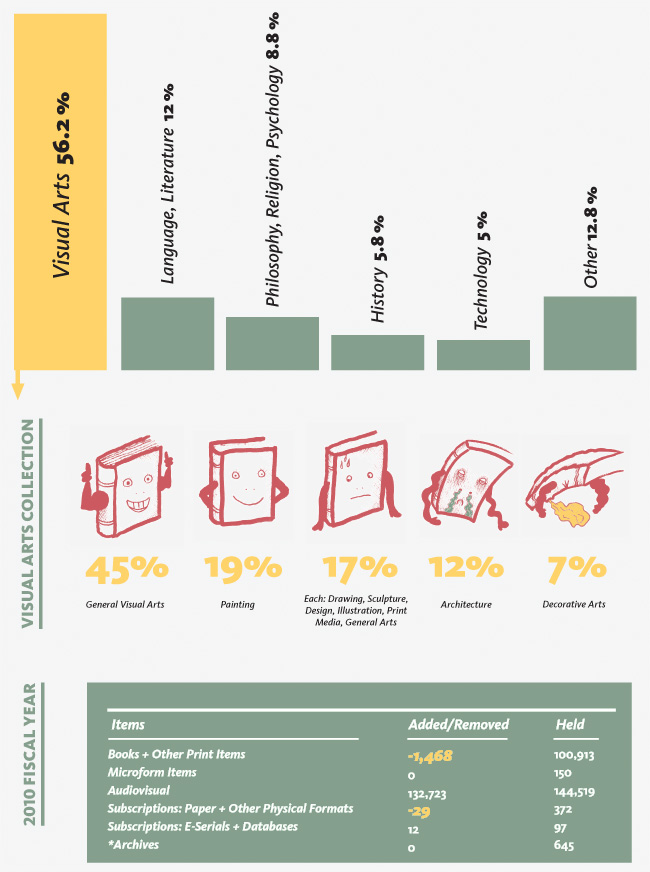It is still early in the semester. There is still time to explore and take full advantage of the school’s resources. Listening to students’ comments and complaints, we sensed a concern about what is and isn’t available at our library. So F Newsmagazine recently decided to research the Flaxman Library, seeking to determine its state of health. Whether you’re one of its most frequent users, or haven’t visited it at all, learning about its strengths, weaknesses and processes, might come in handy during the semester.
Claire Eike, director of the library, gave us input on what Flaxman has to offer and the changes that have been taking place there.
Interview with Director Claire Eike
Daryl Meador: What types of material are given priority in the library?
Claire Eike: Top priority is given to faculty requests to support teaching and learning. Anything that faculty members need for classes or think students should be reading, viewing or listening to, we try to obtain immediately. Students can also request titles or areas for development, and we’ll do our best to honor their interests.
We pay a lot of attention, as well, to what subjects people are researching in the library; what kind of reference questions are asked; what we have to request on interlibrary loan; which visiting artists/lecturers are invited to campus; what our faculty, students and alums are publishing; and any other clues that we get from interacting with library users.
D.M: Is there a possibility for students to request new titles?
C.E: We keep a notebook out in the Reference section in which students can submit requests for new titles. We just ordered a new suggestion box for the library entryway, which should be ready sometime soon. We also have an online form to request new titles at our website. All of that information is used for collection building in the main library and the library special collections – whether people ask for specific artists, authors, titles or just reveal general interests. If it relates to the curriculum or to campus events, we’ll try to collect it.
Some types of materials present special problems. When it comes to games, movies, and digital content (databases, ebooks and images), we may run into licensing terms and/or technical limitations that make some titles impractical or unaffordable in a library setting, even though the content would otherwise be perfect for the SAIC community. As a library, we have to have content that we can technically and legally share.
D.M: How can students access material not kept in the Flaxman?
C.E: I hope most students and faculty know about the I-Share consortium of academic libraries in Illinois. That’s our front line for borrowing from other libraries. It’s heavily subsidized by the State of Illinois, free to the users and completely self-service. You order what you want from the I-Share catalog and it’s usually here at the Flaxman Library within three days. For anything that can’t be found through I-Share, we rely on an international consortium, OCLC – which is known to library users as the WorldCat catalog. You can search WorldCat to find books you’d like to borrow, then ask a library staff member to place an inter-library loan request for you. It’s library-to-library delivery, just like I-Share. The difference is that there are sometimes fees for loans from OCLC/WorldCat partners.
D.M: Flaxman is a very small library in terms of space. What are the efforts to make up for that lack of space?
C.E: We’re investing more in ebooks and ejournals. We have over 20,000 ebooks from springer.com in science, medical, and technology subject areas – all recent publications (2005-2011). They’re listed in the library catalog just like everything else, but with a link that takes you into the ebook instead of a call number that takes you to a shelf in the library. Our SAIC community is reading about everything from plastic surgery to robotics, biomimetics, genetics and synesthesia. Having these kinds of subjects covered digitally means that we can reserve our limited physical space for art books and other materials that are better experienced in visual and tactile formats.
D.M: There are no longer late fines in the library. Does this apply to everything, or only books? How are students held accountable for returning the books so that others can access them?
C.E: Flaxman Library is no longer charging overdue fines for circulating books and CDs. This change is effective for I-Share, as well. There are still fines for recalled and reserved items, as well as videos. Before making this change we ran the stats and discovered that 80 percent of Flaxman Library circulating items are returned on time. Not bad! But not good enough for videos – since faculty depend on reserving them for classes, we need better than 80 percent compliance.
We are still charging $5 overdue fines for movies. Mainly, we rely on the good will of students and faculty to return or renew things on time. If something is overdue for 16 weeks we’ll send a bill for replacement costs – which generally gets people’s attention. The average replacement cost for a printed art book is $50. We have to pay institutional prices for movies, so the average DVD cost for us is probably close to $100, with some well over $300 – a shock to students.
Libraries are built on trust, and it’s easy to abuse – but most people seem to prefer the idea of sharing knowledge. At any given time we are likely to have at least $30,000 of Flaxman Library materials “missing in action” (overdue for 45 days or more). Some of the “lost” items will eventually be returned. Some things are truly lost forever and can’t be replaced. Not only does that mean a loss of your collective investment as tuition-paying students, but losses also undermine the usefulness of the collection. We lose part of the history of thought, teaching and creative interests at the school.
D.M: Are there any future plans to expand the library so as to accommodate more physical material?
C.E: My understanding is that the library will figure prominently in the campus master plan being developed as part of SAIC’s current strategic planning initiative. Print materials are pretty much holding steady, but we’ve reached the point where we can’t continue to add new physical items to the library collections unless we remove old physical items in equal volume. Removing older items that are not being used and are easily available on I-Share is OK up to a certain point. We’ve analyzed the book collections intensively over the past few years and have done a lot to freshen them up. We do have to accept a limited amount of space. Whether we expand the library or simply renovate the current space, it’s still a finite amount of space.
It’s important that we have intelligent discussions now as a campus and develop our vision for the future of the library. We are planning to bring in a consultant this fall to help us begin this process.
Regular Fall/Spring Semester Hours:
Monday—Thursday: 8:30am—10:00pm
Friday: 8:30am—6:00pm
Saturday—Sunday: Noon—6:00pm
For holidays and/or changes please see the calendar at libraryguides.saic.edu
 Elsa Haarstad, 1st Year Undergraduate, Undecided
Elsa Haarstad, 1st Year Undergraduate, Undecided“I can’t find many good novels – other than that, for my interests, it’s pretty good.”
“The movie collection is fantastic and the overall resources extremely accessible.”
“It would be nice if they had overnight hours and if space was more aesthetically pleasing all around.”
 Ensueño Pabon, 1st Year Undergraduate, Writing
Ensueño Pabon, 1st Year Undergraduate, Writing“More fictional novels would be helpful for those in Creative Writing program.”
“The staff is very helpful.”
“I would like to see the library open earlier on Saturdays – just open more hours in general.”
 Stephen Germana, 1st Year Graduate, Sound
Stephen Germana, 1st Year Graduate, Sound“So far, since I’m a first-year student, I’ve only spent about 20 minutes in the library, and it has been a wonderful experience; I have found CDs and recordings that I have not easily been able to find in my life.”
 Annan Shehadi, 2nd Year Graduate Student In Visual & Critical Studies
Annan Shehadi, 2nd Year Graduate Student In Visual & Critical Studies“I find some of the resources I need at Flaxman, but most of the books I get end up being through I-Share.”
“I think the process of checking out books through iShare is very easy and the staff is helpful. A bigger variety of political and cultural studies books would be nice.”
Flaxman’s Catalogued Collection
2010 Fiscal Year

As you can see on the charts, in 2010, the library’s print collections were weeded due to lack of sufficient space to accommodate both growth & retention. In 2010, 3,890 books & other paper/print items added, but 5,358 withdrawn. In subscriptions of paper & other physical formats, 4 were added but 33 canceled. We also found that more than half of the content of the catalog is visual art based, as well as what types of visual arts like painting, architecture and sculpture were more represented over others. Nevertheless, Students and faculty are always welcome to present suggestions, ideas and requests for the improvement of our library.







